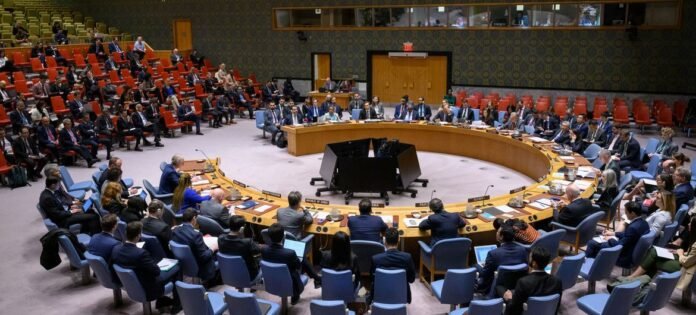Overview of the Security Council’s Warnings
The United Nations Security Council has recently addressed critical issues surrounding Syria’s continuing instability, signaling a need for urgent international attention. In the wake of numerous discussions, Deputy Special Envoy Najat Rochdi articulated the precarious state of the Syrian government, asserting that the nation is on the brink and unable to endure any further escalation of conflict. The warnings issued by the Security Council reflect a consensus that the current geopolitical landscape poses significant threats not only to Syria but also to the broader region.
The council’s assessments underscore the potential for exacerbating existing humanitarian and security crises. With millions of Syrian citizens already facing dire circumstances due to violence, displacement, and economic distress, any escalation could lead to catastrophic outcomes. The implications of increased instability are far-reaching, potentially resulting in the further fragmentation of the state, which could hinder ongoing relief efforts and complicate the delivery of vital aid to those in need. A breakdown in state functions could also create a vacuum that might be exploited by extremist factions, which would further destabilize the region.
The Security Council has expressed serious concerns about the ramifications of prolonged conflict on regional stability, particularly concerning the flow of refugees and the impacts on neighboring countries. Their deliberations emphasize the essential need for a comprehensive approach to address the multifaceted challenges arising from Syria’s instability. Immediate engagement from the international community is deemed crucial to avert a deterioration of the situation, as failure to act could lead to a humanitarian disaster of unprecedented scale.
Security Challenges in Affected Regions
The security landscape in Syria has increasingly become precarious, particularly in locales such as Homs and Hama, where sporadic violence remains a significant concern. These regions have experienced a troubling resurgence of killing, kidnapping, and targeted attacks against minority groups, further destabilizing an already fraught environment. The phenomenon of localized violence illustrates the broader challenges faced by both the interim authorities and the Syrian population at large.
In areas like Homs, sporadic clashes between different armed factions have compromised the ability of governance structures to maintain order. These conflicts are often fueled by longstanding sectarian divides and the competition for resources, creating an unstable atmosphere where the safety of civilians is consistently under threat. Consequently, many residents live in fear, unable to pursue their daily routines without the looming possibility of violence. Reports of kidnappings, specifically targeting individuals based on their ethnic or religious identity, exacerbate the prevailing sense of insecurity among minority communities, often resulting in their displacement or retreat into more secure regions.
The challenges that interim authorities encounter in exerting control over these armed groups underscore the complexities of the security situation in Syria. The absence of a unified and robust judicial system has hindered the enforcement of law and governance, leaving a vacuum that militant factions often exploit. This results in weakened security infrastructure, which undermines the ability of local leaders to provide for the safety and well-being of their constituents. In summary, the ongoing violence and instability in Homs and Hama not only threaten immediate security but also pose long-term implications for the broader socio-political fabric of Syria, making the restoration of peace and order a formidable task. Ensuring the safety of civilians and neutralizing threats posed by armed factions is essential to achieving lasting stability in the region.
The Humanitarian Crisis: A Nation at Risk
The ongoing humanitarian crisis in Syria represents one of the most significant challenges faced by the international community today. As reported, over 7 million individuals have been forcibly displaced due to the protracted conflict, with approximately 75% of this vulnerable population relying on humanitarian aid for their very survival. Displacement has not only led to a loss of shelter and stability but has also severely disrupted livelihoods, making it increasingly difficult for families to access essential resources.
The humanitarian landscape in Syria is further exacerbated by the deteriorating health infrastructure. Years of conflict have decimated medical facilities, with many either destroyed or rendered inoperable, leaving the civilian population with inadequate access to health services. The effects of the most severe drought witnessed in three decades compound the situation, as water scarcity becomes a critical concern. This drought affects agricultural production, leading to increased food insecurity among the population. With limited resources and an overwhelmed healthcare system, the health risks for displaced individuals and host communities are escalating significantly.
<p a="" achieve="" actors,="" agencies="" aid,="" although="" and="" are="" as="" assistance="" bureaucratic="" challenges.="" community="" complexities="" complicate="" concerns="" constraints,="" continues="" crisis="" delivering="" distribution.="" effective="" efforts.="" encounter="" for="" fraught="" funding="" further="" growing="" hinder="" humanitarian="" hurdles,="" impediments,="" in="" including="" international="" is="" large="" lasting="" logistical="" must="" navigating="" need="" needs="" ngos,="" numerous="" of="" operating="" p="" political="" population="" prioritize="" provide="" region.
Political and Regional Dynamics: Moves Towards Stability
The political landscape in Syria has been characterized by significant initiatives aimed at fostering stability and reducing tension among various factions. One of the recent measures taken by the interim authorities includes a fatwa against revenge killings, which seeks to discourage retaliatory violence and promote a culture of reconciliation. By addressing one of the core issues of social division, this religious edict aims to pave the way for a more harmonious societal interaction following years of conflict.
Additionally, the reinstatement of judicial figures who were previously dismissed under prior regimes marks a critical step toward restoring the rule of law and ensuring accountability within the legal framework. This move serves to bolster public confidence in the judiciary, an essential pillar for any effective governance model. Reintegrating experienced legal practitioners not only enhances the capacity of legal institutions but also signals a commitment to inclusivity and representation across various demographics in Syria.
In a bid to enhance political representation, a newly established assembly alongside a committee for elections has been instituted. These platforms are critical for engaging diverse groups, particularly women and youth, in the political process. Such initiatives reflect an understanding of the need for broad participation in governance, allowing for more robust debates and deliberations that capture the voices of a broader demographic spectrum.
However, external factors significantly influence these developments. Recent Israeli strikes in the region pose a complex challenge to the stability initiatives. These aggressive actions not only heighten tensions but also impact the willingness and ability of various stakeholders to engage positively within the political framework. Furthermore, the return of refugees remains a multifaceted issue, with sustainable reintegration dependent on improved security conditions and the availability of essential services. Addressing these intertwined factors will be crucial for achieving lasting stability in Syria.

